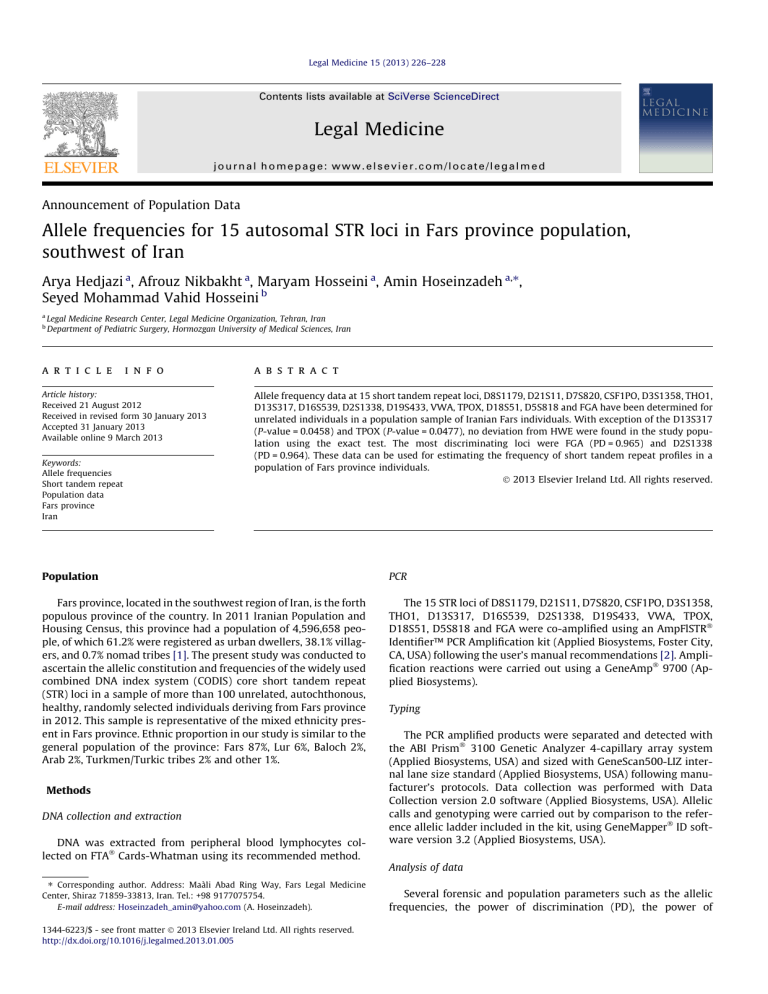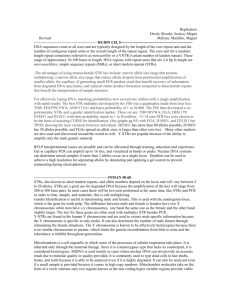
Legal Medicine 15 (2013) 226–228
Contents lists available at SciVerse ScienceDirect
Legal Medicine
journal homepage: www.elsevier.com/locate/legalmed
Announcement of Population Data
Allele frequencies for 15 autosomal STR loci in Fars province population,
southwest of Iran
Arya Hedjazi a, Afrouz Nikbakht a, Maryam Hosseini a, Amin Hoseinzadeh a,⇑,
Seyed Mohammad Vahid Hosseini b
a
b
Legal Medicine Research Center, Legal Medicine Organization, Tehran, Iran
Department of Pediatric Surgery, Hormozgan University of Medical Sciences, Iran
a r t i c l e
i n f o
Article history:
Received 21 August 2012
Received in revised form 30 January 2013
Accepted 31 January 2013
Available online 9 March 2013
Keywords:
Allele frequencies
Short tandem repeat
Population data
Fars province
Iran
a b s t r a c t
Allele frequency data at 15 short tandem repeat loci, D8S1179, D21S11, D7S820, CSF1PO, D3S1358, THO1,
D13S317, D16S539, D2S1338, D19S433, VWA, TPOX, D18S51, D5S818 and FGA have been determined for
unrelated individuals in a population sample of Iranian Fars individuals. With exception of the D13S317
(P-value = 0.0458) and TPOX (P-value = 0.0477), no deviation from HWE were found in the study population using the exact test. The most discriminating loci were FGA (PD = 0.965) and D2S1338
(PD = 0.964). These data can be used for estimating the frequency of short tandem repeat profiles in a
population of Fars province individuals.
Ó 2013 Elsevier Ireland Ltd. All rights reserved.
Population
PCR
Fars province, located in the southwest region of Iran, is the forth
populous province of the country. In 2011 Iranian Population and
Housing Census, this province had a population of 4,596,658 people, of which 61.2% were registered as urban dwellers, 38.1% villagers, and 0.7% nomad tribes [1]. The present study was conducted to
ascertain the allelic constitution and frequencies of the widely used
combined DNA index system (CODIS) core short tandem repeat
(STR) loci in a sample of more than 100 unrelated, autochthonous,
healthy, randomly selected individuals deriving from Fars province
in 2012. This sample is representative of the mixed ethnicity present in Fars province. Ethnic proportion in our study is similar to the
general population of the province: Fars 87%, Lur 6%, Baloch 2%,
Arab 2%, Turkmen/Turkic tribes 2% and other 1%.
The 15 STR loci of D8S1179, D21S11, D7S820, CSF1PO, D3S1358,
THO1, D13S317, D16S539, D2S1338, D19S433, VWA, TPOX,
D18S51, D5S818 and FGA were co-amplified using an AmpFlSTRÒ
Identifier™ PCR Amplification kit (Applied Biosystems, Foster City,
CA, USA) following the user’s manual recommendations [2]. Amplification reactions were carried out using a GeneAmpÒ 9700 (Applied Biosystems).
Methods
DNA collection and extraction
DNA was extracted from peripheral blood lymphocytes collected on FTAÒ Cards-Whatman using its recommended method.
Typing
The PCR amplified products were separated and detected with
the ABI PrismÒ 3100 Genetic Analyzer 4-capillary array system
(Applied Biosystems, USA) and sized with GeneScan500-LIZ internal lane size standard (Applied Biosystems, USA) following manufacturer’s protocols. Data collection was performed with Data
Collection version 2.0 software (Applied Biosystems, USA). Allelic
calls and genotyping were carried out by comparison to the reference allelic ladder included in the kit, using GeneMapperÒ ID software version 3.2 (Applied Biosystems, USA).
Analysis of data
⇑ Corresponding author. Address: Maàli Abad Ring Way, Fars Legal Medicine
Center, Shiraz 71859-33813, Iran. Tel.: +98 9177075754.
E-mail address: Hoseinzadeh_amin@yahoo.com (A. Hoseinzadeh).
1344-6223/$ - see front matter Ó 2013 Elsevier Ireland Ltd. All rights reserved.
http://dx.doi.org/10.1016/j.legalmed.2013.01.005
Several forensic and population parameters such as the allelic
frequencies, the power of discrimination (PD), the power of
227
A. Hedjazi et al. / Legal Medicine 15 (2013) 226–228
Table 1
Allele frequencies of 15 autosomal STR loci in a population sample of Fars province individuals, southwest of Iran.
Allele
6
7
8
9
9.3
10
11
12
12.2
13
13.2
14
14.2
15
15.2
16
16.2
17
17.2
18
19
20
21
21.2
22
22.2
23
23.2
24
24.2
25
26
27
28
29
30
30.2
31
31.2
32
32.2
33
33.2
34.2
35
D8S1179
N = 126
D21S11
N = 125
D7S820
N = 116
CSF1PO
N = 115
0.0040
0.0119
0.0517
0.1595
0.0862
0.0174
0.1111
0.0833
0.1032
0.2198
0.2759
0.1681
0.2478
0.3522
0.3043
0.2778
0.0345
0.0652
0.2143
0.0043
0.0130
D3S1358
N = 126
THO1
N = 126
0.2778
0.2222
0.1468
0.2024
0.1429
0.0079
D13S317
N = 125
D16S539
N = 118
D2S1338
N = 115
D195433
N = 124
vWA
N = 125
TPOX
N = 120
D18551
N = 112
D55818
N = 125
FGA
N = 115
0.0042
0.0040
0.1360
0.0800
0.0508
0.1102
0.0880
0.3320
0.2760
0.0932
0.4110
0.1907
0.0680
0.1229
0.0437
0.0120
0.0169
0.1230
0.2540
0.0040
0.0043
0.0714
0.2817
0.0040
0.0304
0.2262
0.0042
0.1905
0.0040
0.4875
0.1125
0.1739
0.0121
0.0726
0.0040
0.2298
0.0202
0.3024
0.0444
0.1169
0.0766
0.0726
0.0363
0.0081
0.0040
0.1348
0.1000
0.1261
0.0304
0.1167
0.2333
0.0458
0.0600
0.0268
0.0313
0.1518
0.0760
0.2720
0.4120
0.0080
0.1205
0.1440
0.1640
0.2277
0.0280
0.0840
0.1339
0.0040
0.1880
0.0938
0.2800
0.1161
0.1880
0.0840
0.0040
0.0536
0.0223
0.0089
0.0089
0.0087
0.0435
0.1130
0.1391
0.0348
0.1957
0.0087
0.1217
0.0043
0.1391
0.0043
0.1261
0.0435
0.0130
0.0043
0.0217
0.1696
0.0045
0.1000
0.1043
0.0043
0.0120
0.1720
0.2440
0.2120
0.0280
0.0440
0.1120
0.0080
0.1240
0.0040
0.0240
0.0120
0.0040
Table 2
Hardy–Weinberg equilibrium evaluation and forensic parameters for 15 autosomal STR loci in a population sample of Fars province individuals, southwest of Iran.
Allele
Alleles (N)
D8S1179
9
D21S11
13
D7S820
8
CSF1PO
6
D3S1358
6
THO1
6
D13S317
9
D16S539
8
D2S1338
12
D195433
13
vWA
8
TPOX
6
D18551
13
D55818
9
FGA
15
Ho
He
P
PD
PIC
PE
0.8254
0.8299
0.6638
0.942
0.81
0.647
0.8400
0.8377
0.9154
0.949
0.81
0.675
0.8017
0.8141
0.1203
0.925
0.78
0.583
0.6522
0.7203
0.1098
0.874
0.66
0.358
0.7381
0.7698
0.6588
0.904
0.73
0.490
0.8333
0.7936
0.4039
0.914
0.76
0.662
0.7600
0.7793
0.0458
0.904
0.74
0.527
0.7712
0.7591
0.1864
0.903
0.73
0.547
0.8783
0.8775
0.4731
0.964
0.86
0.751
0.7419
0.8250
0.2409
0.946
0.80
0.496
0.7920
0.8131
0.2061
0.931
0.78
0.584
0.6500
0.6824
0.0477
0.836
0.64
0.355
0.8571
0.8690
0.0943
0.959
0.85
0.709
0.7280
0.7283
0.9140
0.887
0.68
0.473
0.8522
0.8779
0.2665
0.965
0.86
0.699
Ho: observed heterozygosity, He: expected heterozygosity; P: Hardy–Weinberg equilibrium exact test in the study sample; PD: power of discrimination; PIC: polymorphic
information content, PE: power of exclusion.
exclusion (PE), the polymorphic information content (PIC), and observed heterozygosity (Ho) and expected heterozygosity (He) of
the 15 loci were calculated using PowerStats version 12 software
package [3,4] while, Hardy–Weinberg equilibrium (HWE) analysis
was carried out for each locus by the exact test using a Markov
Chain (Arlequin version 3.1).
Access of data
Available upon request to afrouz.nikbakht@yahoo.com.
Results and other remarks
Allele frequency data of the 15 STR loci are presented in Table 1.
HWE evaluation and forensic parameters are included in Table 2.
With exception of the D13S317 (P-value = 0.0458) and TPOX (Pvalue = 0.0477), no deviation from HWE were found in the study
population using the exact test.
The observed heterozygosity of the 15 STR loci screened in this
study ranged from 0.6500 (TPOX locus) to 0.8783 (D2S1338 locus)
indicating that all the loci are highly polymorphic and could be
used in determination of identity.
228
A. Hedjazi et al. / Legal Medicine 15 (2013) 226–228
These loci could distinguish between two unrelated people
since the combined PD and combined PE of them was very high
(combined PD = 0.9999999999999999 and combined PE =
0.999998). The PE of the D2S1338 locus (PE = 0.751) was higher
than the other loci, whereas the PE value of the TPOX locus
(PE = 0.355) was the lowest. The most discriminating loci were
FGA (PD = 0.965) and D2S1338 (PD = 0.964).
Using STRs in forensic analyses effectively requires population
data, especially those that define the general population(s) of the
area where the crime was committed. To our knowledge, a great
body of the literature has been published by experts on forensic
medicine, determining the allele distributions at different STR loci
of the several population samples [5–9]. In Iran, the specialized literature does not present a similar population data as we described
here.
Financial disclosure
Authors had no grant or funding source.
Acknowledgement
We are grateful to the Legal Medicine Organization of Fars for
funding this research project. The authors declare that they have
no conflict of interest.
References
[1] Statistical center of Iran. (<http://www.amar.org.ir/Default.aspx?tabid=133>
[accessed October 28, 2012].)
[2] AmpFlSTR1 IdentifilerTM PCR Amplification Kit User’s Manual. Appl Biosyst,
Foster City, CA, USA; 2001.
[3] Marshall TC, Slate J, Kruuk LEB, Pemberton JM. Statistical confidence for
likelihood-based paternity inference in natural populations. Mol Ecol
1998;7(5):639–55.
[4] Slate J, Marshall TC, Pemberton JM. A retrospective assessment of the accuracy
of the paternity inference program CERVUS. Mol Ecol 2000;9(6):801–8.
[5] Cainé LM, Zarrabeitia MT, Riancho JA, Pinheiro MF. Genetic data of a Brazilian
population sample [Santa Catarina] using an X-STR decaplex. J Forensic Leg Med
2010;17(5):272–4.
[6] Barni F, Berti A, Pianese A, Boccellino A, Miller MP, Caperna A, et al. Allele
frequencies of 15 autosomal STR loci in the Iraq population with comparisons to
other populations from the middle-eastern region. Forensic Sci Int
2007;167(1):87–92.
[7] Bai X, Cong B, Li S, Guo X, Li X, He L. Allele frequencies for six miniSTR loci of
Northwestern Chinese Han populations. J Forensic Leg Med 2009;16(8):469–71.
[8] Carvalho R, Pinheiro MF. Study of DXS9895 and DXS7130: population data from
North of Portugal. J Forensic Leg Med 2011;18(1):21–2.
[9] Yavuz I, Sarikaya AT. Turkish population data for 15 STR loci by multiplex PCR. J
Forensic Sci 2005;50(3):737–8.


